In the previous post we were in Kolkata, West Bengal. This week we’re in the Carondelet neighborhood of St. Louis, Missouri. We’ve also traveled back in time another ten years. As you can see, it’s a little colder in St. Louis, but not too cold. A light jacket is all you need for winter sports!
The carte-de-visite above was made by a photographer named Tobias. The photo was probably taken in the 1860s in his studio on the corner of Main Street and St. Louis Street. Henry Tobias operated a studio nearby in the 1870s. I haven’t been able to confirm that it was the same man, but it probably was.
Tobias used a pen to darken one of the boy’s eyes, which was a common practice in the nineteenth century (usually both eyes were darkened or neither of them). I took the liberty of lightening the mark a tiny bit in the image above, but you may still notice it below.

The back of the photo has a simple inscription: For Mama.


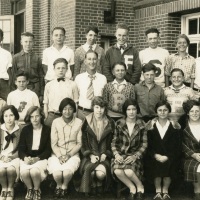



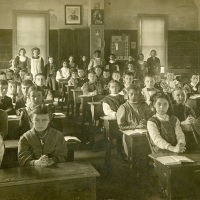

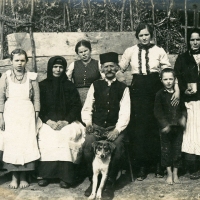
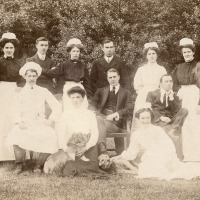
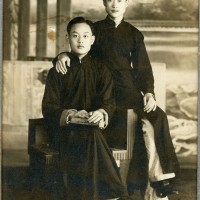
Sweet inscription! I wonder if he went on his own to have his photo made for mama or if a family member helped.
LikeLiked by 3 people
Good question. 🙂
LikeLike
That’s a cute little chap, love how they put ‘skate marks’ on the floor 🙂 and aw, For Mama, so lovely.
LikeLiked by 2 people
Though rather small, his skating pond is quite realistic looking. 🙂
LikeLiked by 1 person
I first thought he was wearing boot skates that were first invented about 1848 but on closer inspection, he is wearing the clip on type skate. In the photo, his shoe is shorter then the length of the skate. Makes sense that, if the picture was taken in a studio which it most probably was given the fake snow, that the photographer would have strap on or clip on skates that could be used with more clients with larger or smaller feet.
LikeLiked by 2 people
I hadn’t noticed the skate length compared to his boots. You’re very observant, Bob!
LikeLike
What a cute little guy! I love his hat. I’m sure his Mama was very happy to receive this photo.
LikeLiked by 2 people
Yes, the hat! It looks like it might be a variation on a tam o’ shanter. After posting yesterday, I noticed he’s also wearing a little tie.
LikeLiked by 1 person
Such a sweet photo! From the handwriting, I’m wondering if the inscription might have been made by the boy’s mother to her mother.
LikeLiked by 3 people
That makes sense. The handwriting certainly looks more practiced than that of a youngster.
LikeLiked by 2 people
I had that thought as well. It may or may not be relevant, but I bought the carte from a dealer in Stratford-upon-Avon, which raises the possibility that the photo was sent to the boy’s grandmother in England. There’s no way to know for sure.
LikeLiked by 1 person
But always interesting to speculate!
LikeLiked by 1 person
Absolutely!
LikeLike
I had hoped that this lad and T.S. Eliot might have been boyhood chums, but Eliot wasn’t born until 1888, so it’s not likely. On the other hand, they were close to being neighbors. Eliot grew up on Locust Street, which ends approximately at the Gateway Arch today, and the Carondelet district, which grew up around Elwood Street, is also near the river and just south of Eliot’s neighborhood. I really enjoy it when I can find a way to contextualize some of these images, juxtaposing them with facts about others who were alive and around at the time.
LikeLiked by 1 person
You’re so right, Linda. Context often makes the images more interesting and meaningful. I sometimes get a contextual inspiration, but not always. In this case, I could have talked about the popularity of ice skating in the 1860s, but felt it would distract from the photo. I’ve never been to St. Louis, so it was interesting to read what you wrote about it.
LikeLiked by 1 person
Somewhat sad knowing this card wasn’t kept by the family, but I understand how it happens. By sharing these photos, you open windows to lives we would never have known. I hope this one was treasured at least by somebody’s mother!
LikeLiked by 2 people
Thank you, Mary Jo! It must have been treasured by someone. It has a dreamlike quality which adds very much to the appeal, I think.
LikeLiked by 1 person
This is just so sweet.
LikeLiked by 1 person
I didn’t realize it was common practice to darken someone’s eyes with a pen. Good to know.
I love this photo, with the random tree and the fluffy snow arranged just so.
LikeLiked by 1 person
I would say eyes were darkened in maybe 1 out of every 20 paper photos in the 1860s and 1870s, and the practice faded over time. By the 1880s it was much less common, and by the 1890s it was almost never done. In the early days, photography was often viewed as lacking in artistic qualities, so professionals would actively promote their ability to enhance images with artistic touches. Over time, photography came to be viewed as a creative endeavor that could stand on its own.
LikeLiked by 1 person